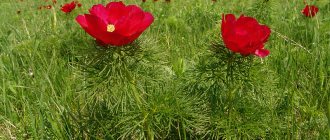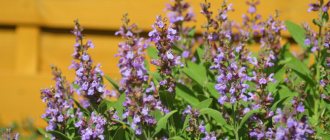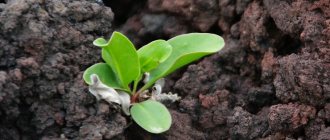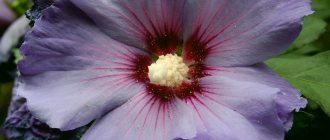- October 13, 2019
- Flowers
- Lyudmila Antonova
Evading peony (Paeonia anomala) is a perennial herbaceous plant of the Peony family. Another name is Maryin root or Maryin grass. The plant was first bred in the 18th century.
After its appearance, the plant could be found exclusively in botanical gardens. Currently, the Maryin root flower is actively used in the field of medicine and cosmetology. It is distinguished by its resistance to adverse conditions.
In this article we will study in detail how to plant the Maryin root flower and the care that the plant needs, and also consider the signs and properties of the plant.
Botanical description of the plant
When starting a conversation about Maryin root, planting and caring for the plant, we should talk about the botanical characteristics of the flower. This is necessary in order to have a complete understanding of the flower and understand what conditions it will need for optimal growth and development.
To make a botanical description, you should carefully look at the photo of the Maryina root flower.
This is a large plant, the length of its stems can reach one meter. The root system of the Maryin root flower consists of a massive tuberous rhizome with numerous fleshy brown adventitious roots. The inside of the root is light and has a specific smell. Sometimes the root of an adult plant weighs 5-6 kg, as it tends to store nutrients and moisture. Peony root is valued in the medical field.
Looking at the photo of the Maryina root, we can conclude that the stems of the plant are hard, thick, erect, single-flowered, and have leathery scales at the base. The leaves are compound, alternately arranged, large (up to 30 cm in length, 2.5 cm in width), with petioles. By autumn they change color from green to dark red.
The Maryin root flower is single, large, can reach 14 cm in diameter, and has a double perianth. The corolla consists of five purple-pink petals. The number of pestles is usually from 2 to 5 pieces. Stamens are numerous. The calyx consists of five green leaves. Maryina grass begins to bloom early. During drought and heat, the flowering period is reduced.
In August, the formation of the fetus occurs. The fruits of the plant are multi-seeded star-shaped leaves, which, when ripe, open along the length of the ventral suture. The seeds have a slight shine and black color.
Description: varieties and varieties
There are quite a lot of varieties and varieties of peony.
It comes in the form of a herbaceous plant and shrub. It is also found in the form of a subshrub. In nature, on the territory of our country, marin root can be found in some places of the wooded strip of European territory and in Siberia. It settles on taiga edges in forests, meadows and along floodplains, in mountainous areas. For a long time, this type of peony has been used to decorate gardens. In the photo you can see how great it looks, especially in bloom. Maryin root is excellent for open ground, withstands even the harshest winters, and is very easy to grow and propagate.
Maryin root - a type of peony
When grown in garden plots, this peony variety reaches a height of 1 m. Under favorable conditions, it can sometimes be larger in size. It grows as a bush with several erect branches. Each branch has several complex and large-sized leaves, which reach a length and width of about 30 cm. It blooms profusely, for about two weeks. Flowering time occurs from late spring to June. The flowers are large, about 15 cm in diameter, sometimes larger. The color is crimson or pink-purple. The root system of the plant is well developed.
Tales of Peony
Maryina grass has been known since ancient times. Mention of it can be found in many legends. There is an interesting myth about the name of peony. In Ancient Greece there lived a talented doctor and his name was Paean. He skillfully treated both the Olympian gods and people. He did it so well and saved so many lives that Paean's teacher began to envy him. The teacher, obsessed with envy, decided to poison his student, but at the right moment the gods came to the rescue and turned Paean into a beautiful bush strewn with flowers. Since then, this bush has been called a peony, and it continues to help people in the fight against diseases and illnesses, and photos, care and planting of the Maryin Root flower are important sections of many botanical books.
Maryin root was also endowed with magical powers. It was believed that he could ward off poisonous snakes and evil spirits, and also heal the possessed. Where there is a flower, evil spirits do not dare to show themselves. Necklaces and amulets were made from it. It was believed that replanting and digging up a plant could only be done at night, otherwise you could lose your eyesight. Girls who dreamed of getting married believed that if you grow a peony bush in the garden, you will definitely meet your future husband. And married couples were recommended to put peonies in the bedroom in order to rekindle their former passion.
Spreading
Maryin root is a rare species with a certain distribution zone. Peony can be found in Russia (Siberia, the Urals, Perm Territory and the Komi Republic), China, Mongolia and Kazakhstan. The Mongols call it “purple peony”, the inhabitants of the Middle Kingdom call it “Xinjiang Peony”. In some areas, the plant is listed in the Red Book, and a photo of the Maryin Root flower is presented in botanical museums for clarity. After all, everyone needs to know what a rare plant looks like in order not to pick a flower while walking through the forest.
What it looks like and where it grows
The herbaceous plant is found in mixed, small-leaved and coniferous forests (glades), and also grows near rivers in sunny places. You can find it at the edge of the forest or in a meadow, sometimes even among tall grasses. The plant is also grown in garden plots.
The height is about 1 m, in the upper part there are large flowers, purple or pink. The root system is horizontal, consisting of a thick spindle-shaped tuber and a brown branched root. In its purified form, the root is white with a pronounced aroma and sweet taste.
Maryin root is recognized as an endangered species, therefore it is listed in the Red Book (Komi Republic in the Russian Federation, Kazakhstan). The most common peony of this type is in Siberia. Grows in Kazakhstan, Altai and western Yakutia. The herbaceous perennial is grown not only for the preparation of medicines, but also for decorative purposes for landscaping cities. It is frost-resistant, grows only in soil saturated with nutrients, and is resistant to pests and diseases.
Collection and storage
Medicinal raw materials are collected from bushes that bloom purple. From each bush that is at least three years old, it is harvested only once every 5–6 years. The entire growing season is suitable for harvesting, but it is advisable to collect raw materials in the fall. Both grass and roots are used for treatment.
The bushes are not dug up. Using a sharp knife or sickle, cut off the parts located on the outside. First, the bush is dug up and the soil is washed off from the selected part of the rhizome. No more than ⅓ of the root is cut off, then the cut site is treated with charcoal and covered with soil.
The upper part of the plant is harvested during the peony flowering period - in June, the lower part - in the second half of August or in the fall, when the seeds are ripe. The petals are collected at a time when they are just beginning to fall. The roots are thoroughly washed and cut into strips (about 3 cm thick, up to 15 cm long) using a knife. The raw materials are dried under a canopy; you can lay them out in a cool room with dim lighting and good ventilation. It is important to turn it over regularly to prevent rotting.
The root and other parts of the plant are harvested when they become brittle and break easily. The roots and aerial parts are dried separately, do not mix. You can leave the raw material for 2–3 days so that it wilts, and then dry it in the dryer (temperature 45–60 degrees). The finished raw material acquires a brownish-yellow or dark brown color.
In the autumn, the above-ground part of the bush withers, and the maximum amount of useful substances is concentrated in the root. The dried roots are sweetish-hot and are stored separately from the above-ground parts of the plant. To prevent the essential oil from evaporating, sealed containers are used for storage - dark cardboard boxes. Optimal conditions are a cool, moisture-free place. Raw materials are good for the body for 3 years after harvesting; after this period, toxic substances accumulate in them. For greens, this period is reduced to 2 years.
This is interesting: Lavender - cultivation, varieties, planting material, basic care + 91 photos
Maryin root: planting and care during vegetative propagation
The process of vegetative propagation is carried out by dividing the rhizome of the plant. It is necessary to divide it so that each part contains roots and buds. Cuts on the divided parts should be treated with charcoal powder and air dried. After this, the blanks are placed in recesses 50 cm deep, filled with a mixture of garden soil, sand and black soil with the addition of potassium salts and superphosphates. The empty space is filled with fertilized soil and moistened abundantly. For healthy growth, Maryina root needs space, so there should be a distance of more than 70 cm between plants.
As a rule, it is in the fall that the Maryina root is planted; care at this time should be special. It is necessary to ensure that the cuttings do not freeze. The plant quickly takes root and easily adapts to new conditions. It should be expected that the plant will not produce flowers in the first season.
Maryin root: propagation by seeds
In nature, Maryina grass reproduces by self-sowing. If you want to grow your own grass in the garden, you will have to work hard. Plants are not able to germinate quickly, which is due to their thick shell. The process, although not easy, is quite interesting.
So how to grow Maryin root from seeds? To begin with, the collected seeds must undergo pre-treatment:
- First stage. Place the seeds in soaked sand or on soaked cotton pads. The ambient temperature should be about +20-25 degrees Celsius. The duration of the first stage is 2 months. During the first stage of planting Maryina root, caring for the plant must be very careful. During this period, you need to monitor the seeds, maintain constant humidity and make sure that mold does not form. It will be most convenient to place the seeds on a tray, Petri dishes or ordinary plates.
- Second phase. After a couple of months, the seeds must be placed in a cool place with a temperature of +3-4 degrees Celsius. You can use the refrigerator. At this stage, it is worth moistening the Maryin root flower seeds once with a 0.1% solution of potassium permanganate. This procedure is carried out in order to avoid the formation of fungal infections. This period lasts a couple of months and should end with the emergence of seedlings.
- Third stage. After this, the seedlings are planted in pots, which are placed in a sunny but cool place. To obtain good seedlings, you can use phytolights. You also need to constantly feed and water young plants. It is recommended to use Gummi fertilizer three times during the growing period of seedlings. The first time was two weeks after landing, a month later - the second time, a month and a half later - the third time. This stage will last two to three months. When the seedlings are strong enough, the plant is planted in open ground.
Planting and caring for Maryina Root is a fairly simple task that even a novice gardener can handle. The plant is not picky; caring for this representative of the flora is not difficult.
Diseases and ways to combat them
Peony has good immunity to various diseases. The only problem that gardeners may encounter is gray rot, which occurs due to improper watering.
Preventive measures will help avoid this problem. To do this, pour a fungicidal solution under the bush of each plant. Repeat three times with an interval of two weeks.
Dangerous pests that can be found on a flower are:
- bronze;
- aphid;
- ants.
You can get rid of them with the help of insecticides and folk remedies. Use in accordance with the instructions, otherwise you can harm the physiological process of plants.
Choosing a landing site
An important role is played by the place where the Maryina root will be planted and cared for. The flower cannot be grown close to buildings and trees, since the plant prefers spacious and free areas. Also, before planting, you should make sure that there is no groundwater in the chosen location. If they are present, the plant will die. In areas where precipitation accumulates, the plant will also not be able to survive. Loose soil enriched with mineral and organic substances is perfect for peony.
Economic importance and application [edit | edit code]
Peony herb (lat. Herba Paeoniae anomalae), rhizome and root (Rhizoma et radix Paeoniae anomalae) are used as medicinal raw materials. The grass is harvested during the flowering period, the rhizome and roots are harvested at any time during the growing season, preferably simultaneously with the grass [2]. The raw materials are used to prepare a tincture, which is used as a sedative for neuroses, insomnia, etc. [10]
The plant is considered poisonous and has limited use in folk medicine for stomach diseases, epilepsy, and cough [10].
In Siberia, the roots are used as a seasoning for meat [10].
The shirking peony is popularly called Maryina grass or Maryina root. The flower grows in light forests, river valleys, and meadows with fertile soil. The healing properties of its roots have long been used in folk medicine. Infusions and decoctions are prepared from the plant to help cure colds, gynecological problems, and digestive disorders. Due to its decorative qualities and unpretentiousness, the evasive peony is popular as an ornamental garden crop.
Watering
It is not recommended to water Maryin root frequently, as waterlogging can cause the plant to rot. But this does not mean that you should ignore watering. It is advisable to irrigate the burnt grass once every 7 days. Each bush consumes about 10-20 liters of water. It is very important to water the plants in early spring, as flowers form at this time, and also in August, when buds begin to form. After irrigation, loosening the soil will have a beneficial effect on the plant. This is required for air exchange. After loosening the soil, it is recommended to get rid of weeds that interfere with the growth of the peony.
Growing from seeds
Under natural conditions, the extraordinary peony reproduces by self-seeding (except for places where the seeds do not have time to ripen). Shoots may appear in the spring or delay for 1-2 years. Growing a flower from seeds at home will require a lot of time and patience. You can't count on flowering soon. Poor seed germination is due to the durable shell. To activate growth, stratification is used - alternating exposure to heat and cold.
Advice. Start collecting seeds before they are fully ripe, but not earlier than mid-August. Their shell is softer and lighter.
The seeds of the evasive peony are brown, smooth and elastic. Size 0.5-1 cm. They are sown immediately after collection in open ground or prepared containers with substrate. In nature, seeds undergo a natural process of stratification; at home, it is created artificially. In the first year after wintering, plants take root. Leaves and shoots will appear only after a year. During the cold period, the beds with seeds are mulched with straw and dry leaves. In cold regions, they are additionally covered with spruce branches.
Fertilizers
After planting, the Maryin root should not be left - care should include the introduction of fertilizers. It is better to fertilize young plants using the foliar method: it is recommended to irrigate the plant once a month with a solution of mineral fertilizer (Ideal is perfect) from a watering can. For a greater positive effect, add a soap-based solution. The best time for the procedure is the end of the day.
Adults are fed 3 times, every month. Fertilize the plants with a solution consisting of urea and water with the addition of organic elements. It is most effective to fertilize mature, strong plants at the root.
Each period of growth requires certain chemical elements: nitrogen - at the beginning of the growing season, during the formation of the inflorescence and active flowering - calcium, nitrogen and phosphorus, and when the plant forms buds - phosphorus and potassium are necessary.
Instructions on how to grow peony from seeds at home
The collected seeds are soaked overnight in water with the addition of the growth stimulant “Epin”, “Heteroauxin”. Stratification is performed according to one of two schemes:
The first option is more effective, let's focus on it.
First phase (warm):
- Fertile soil (2 cm) and sand (2 cm) are poured into a wide container. Well moisturizes.
- The soaked seeds are laid out on the surface and covered with a 1 cm layer of sand.
- The container is covered with glass or film and placed in a warm place with a temperature of 28-30°C during the day and 15°C at night. This temperature regime is maintained for 2 months. Heating radiators, an electric heating pad and directional lamp light will help provide heating. The soil is moistened with a spray bottle and ventilated once a week. By the end of the first warm phase, white roots appear.
Second phase (cold):
- It is necessary to pinch the tip of the spine (carefully!).
- A separate pot or glass is prepared for each plant; you can buy peat tablets. Universal soil for flowers is poured into each container and a sprouted seed is placed.
- The pots are covered with film to retain moisture and transferred to a room with a temperature of 6-10°C.
- This period takes 3-4 months. The soil is periodically moistened and ventilated. As a result, the first leaf appears.
- Attention. Treatment of cotyledons with a solution of gibberellic acid (growth hormone) accelerates the appearance of leaves.
Third phase (warm):
- The seedlings are transferred to a warm room with a temperature of 18-23°C. Keep under cover, moisturize, and ventilate.
- The third stage has a different duration; seedlings can be planted in the spring or wait until August. The second option is preferable; by the end of summer the sprouts will get stronger.
Advice. Purchased seeds are drier due to long storage. Soak them for 2-3 days. Before planting, you can lightly rub the shell with sandpaper or sand.
While the seedlings are waiting to be planted in open ground, they need to be looked after. In addition to moisturizing, treatment with a fungicide will be required. The procedure will eliminate infection with rot and other diseases. For peonies, choose a bright place with slight shading, away from lowlands and groundwater. The area must be protected from the wind. When planting, care should be taken not to damage the thin roots. They operate using the transshipment method, removing the seedlings along with a lump of earth.
After filling the hole, watering is carried out. The surface is mulched with straw. Before frost, the young plant will have time to take root in its new location. In spring the buds will begin to grow. The first flowers will appear no earlier than after 4 years.
Application in medicine
This representative of the flora is known for its rich content of organic and mineral components that have a beneficial effect on the human body. It is intensively used in medicine.
Medicines based on parts of the Maryina root have analgesic, anti-inflammatory, bactericidal, expectorant, sedative, and tonic properties, and also normalize blood pressure, increase immunity, reduce appetite, reduce aggression, improve sleep and generally have a positive effect on the central nervous system and mental health person.
Another property is stimulation of the production of endorphins or happiness hormones.
Maryina grass is also used to improve the health of the female body. During menopause, this tincture helps to cope with its consequences.
The plant helps fight anxiety, mood swings, depression, relaxes and calms. It is recommended to take peony-based tincture to regulate the monthly cycle and relieve menstrual pain. Also, the herb, in combination with other medications, fights such neoplasms in women as fibroids and cysts.
The use of tincture has a beneficial effect on men. It is a highly effective remedy for restoring potency.
Tinctures are perhaps the most popular medicine produced from Maryina root. They are usually made with water and alcohol. Also popular are decoctions prepared from the peony Maryina root. At the pharmacy you can buy a dry extract from this healing representative of the flora.
The underground and herbal parts of peony are used to make medicines. These parts are collected during the period of active flowering. Caring for and planting Maryina root for medicinal purposes is no different from planting a plant to decorate a garden.
Maryin root: properties and contraindications, cultivation and use
Author: Natalya February 15, 2021 Category: Garden plants The evasive peony, or the extraordinary peony, or the irregular peony, or the marin root, or the marin root peony (lat. Paeonia anomala) is a species of herbaceous perennials of the genus Peony, growing mainly in Siberia on the edges and meadows , clearings of mixed forests and river valleys.
This species is classified as endangered, as confirmed by the Red Book of the Komi Republic. The species definition “anomala”, which translates as “irregular”, “unusual”, was given to the plant due to the fact that its color in autumn differs from the color of other types of peony. This species has been in cultivation since 1788. The evasive peony is grown both as an ornamental and as a medicinal plant, but when they talk about the healing properties of this species, they often use its other name - marin root.
Popular traditional medicine recipes
To prepare a tincture with alcohol, you will need 60 g of pre-dried rhizome, which must be poured with a strong alcoholic drink (vodka or alcohol is often used). The root is infused for three weeks, enriching the liquid with useful substances, then it is filtered and taken for one month. This tincture helps get rid of anxiety, stress and insomnia, and also improves the general condition of the body. In ancient recipes they wrote about the property of the tincture to fight infertility.
To obtain a decoction for the treatment of gastrointestinal diseases, take 15 g of well-crushed parts of the root system of the zhgun-grass and pour boiled water. The solution is boiled over low heat for 9 minutes. When the mixture cools, it is filtered. It is advised to take the decoction 20 minutes before meals, three times a day.
To obtain a strengthening tea drink, you need to brew several petals of the Maryina root flower in one glass of boiled water. The resulting tea is taken 2 times a day. The drink stimulates the immune system; in cold weather, tea is taken to avoid colds.
Is it poisonous?
Despite the fact that peony is so valued in medicine and many medicines are made from its parts, Maryin root is still a poisonous plant. There are certain contraindications to its use. Therefore, it is not recommended to take medicines made from the root without consulting a doctor as it may adversely affect your health. Be sure to consult a specialist before starting treatment.
Remember: evasive peony is a toxic plant. People with low blood pressure, kidney failure or individual intolerance should be wary of using such medications. People suffering from gastritis and high stomach acidity should not take the drug. To avoid side effects and allergies, it is forbidden to increase the dose and time of treatment. When the dosage is higher than normal, the central nervous system is suppressed. The use of medicines from Maryina root is also contraindicated for children and pregnant women.
Use in cosmetology
Zhgun-grass contains many useful components, therefore it is used in cosmetology. The plant has been used in the beauty industry for many years.
The herb strengthens the hair roots, activates their growth, gives a healthy glow and helps reduce the secretion of oil and dandruff on the head. It is recommended to rub diluted infusions (not alcohol) into the scalp. It is also useful to add the infusion to water to rinse your hair.
Due to the fact that Maryin root contains essential oils, it is an excellent component of face creams. Its extract helps fight skin aging, and therefore is used to make creams and emulsions aimed at combating aging.
Infusions prepared from Maryina root are effective in the fight against acne and blackheads, since they contain salicylic acid. It is this that acts as a disinfectant on oily skin and dries it out. For some dermatological ailments it is used to heal wounds.
Use in cooking
In addition to its widespread use in cosmetology and medicine, its use in cooking can be added to the description of Maryina root. The underground part of the grass is edible. In wartime, it was used as food (boiled, fried and baked), and flour was also made from the root. Nowadays, Maryin root is most often added to dishes as a seasoning. In some regions of Kazakhstan, porridge is cooked from it. Tea prepared with the addition of this plant is also popular.
Having looked at the photo and description of the Maryina root, we can say that this is an amazing and beautiful flower that plays a significant role in different areas of human life.











